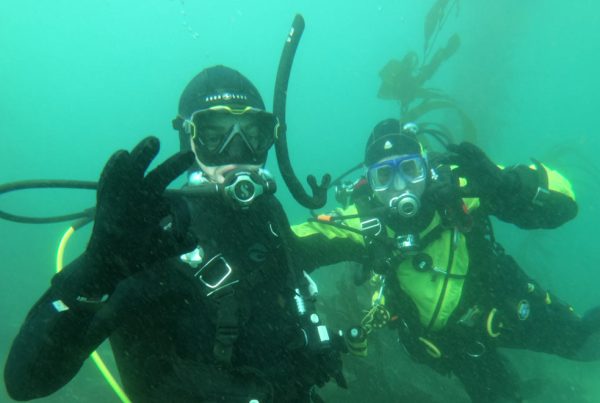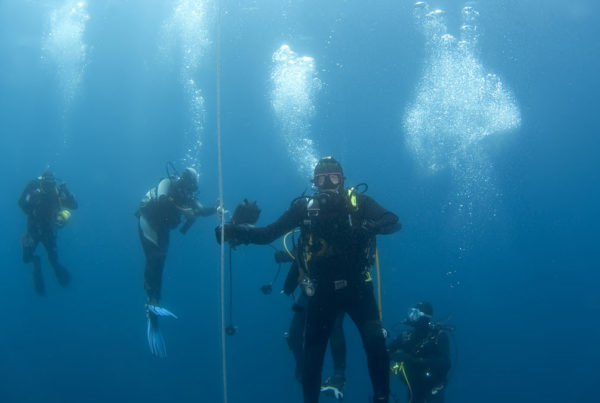When we dive, wandering around the bottom is usually not beneficial and can lead to a boring, pointless underwater excursion. The adage “plan your dive and dive your plan” is not just for safety but also for enjoyment. A plan of where you are going, how long it will take you to get there, how long you will be there, and path back will help your diving pleasure immensely. This is especially important in beach diving. Underwater navigating for beach diving takes additional knowledge and skill. Also, as with any plan, flexibility is also important. Mastery of this knowledge plus your skills will make flexibility easy and beneficial.
FINDING A DIVE SITE
When we dive from a boat, finding a dive site is easy with GPS and depth finder. In beach diving, however, we do not have the benefit of these electronic devices. We will find ourselves working with a compass, good ol’ fashion eyesight and brain power.
If you are looking to find and record a new dive site, you can use several sources. First is simply scuttlebutt around your local dive shop or club. Sometimes you can even get specific directions, but most of the time no. Another source is your eyes and good pair of binoculars. A submerged site gives away its location by a number of hints. Kelp growth is an obvious clue. Another is the deformation of wave patterns, including a wave breaking over the high point of a submerged reef. If it is a day of clear water you could scan the nearshore ocean for areas of darker water indicating a submerged reef. And finally, congregating marine life such as fish, birds, otters, sea lions, etc. sometimes gives away the location of submerged structures. Once you think you have new dive location in sight, a compass is a must. Take a heading from your point of entry to the new location. This is the heading you will be taking on your new venture.
COMPASS HEADINGS
On the surface, if you have line of sight to your dive destination (a kelp forest, offshore rock, etc.), take a heading, turn the bezel on your compass and you have a direction — but how far? If you are good at estimating distances, and know what your “kick cycle” is (how many kicks take you how far), you can get a very rough idea on how to get there.
Another way to use the compass is for triangulation. If logging the site for the first time, surface and take a heading to a fixed point on shore—the end of a pier, a telephone pole, a rocky point. Take a second heading in another direction. Take both headings with as much precision as possible and note each. To re-find your site you now need only position yourself on the surface where both landmarks line-up to their individual headings.
LANDMARK TRIANGULATION
Landmark triangulation method is even more effective than compass triangulation and, done properly, very accurate. On the surface, position yourself over the dive site. For maximum accuracy, use a buoy with a line anchored to the site. In one direction, find two shore landmarks that lineup with each other—a telephone pole with a the edge of a building, for example. Each landmark should be as permanent as possible, far apart from each other, as narrow as possible, and stand out from the background as much as possible. Face another direction down the shore and do the same with two more landmarks. Keep copious and detailed notes on a slate.
NATURAL NAVIGATION
Bottom profile, sand bottom and sun angle become especially helpful in navigating underwater on a beach dive. Ripples on a sand bottom pretty much line up parallel to the shore. Head perpendicular to the ripples and you are either heading out, or heading in. That is where bottom profile comes in. Deeper, you are heading out; shallow, in.
Knowing the place of the sun in the sky at the time of day you are diving is also helpful. If you are diving early A.M. and the sun is behind you, odds are you are heading west.
LONG SHORE CURRENTS
Long shore currents can wreak havoc with navigation plans. If there is a moderate surf hitting the beach at an angle, there will be a net movement of water at and near the surf zone down the beach in the direction the surf is moving. If you take a compass heading out to a dive site, then move through the surf zone based on that compass heading, you will be off. Learn to recognize the angled surf, longshore current and adjust accordingly.
CONCLUSION
At its most basic, know on your compass dial, and by looking at the bottom, which way shore is, and which way is deep open ocean. Spending an entire dive cruising over a featureless sand bottom is boring. Ending up hundreds of yards is offshore with an empty tank is stupid, dangerous, and will not happen with some basic knowledge and practices.










